Today, the books we read are generally new, printed within the last fifty years and in good condition. How will these books we read today look in three hundred years? An Historical Account of the Incorporated Society for the Propagation of the Gospel in Foreign Parts Containing their Foundation, Proceedings, and the Succeses of their Missionaries in the British Colonies, to the Year 1728 was an exceptionally high-quality book when first published. After nearly three centuries of use at Dickinson College, parts of the book are in a pitiful state.
As a religion minor, I choose to study this book as I have an interest in early modern religious history, especially the Reformation and British faith disputes in the sixteenth, seventeenth, and eighteenth centuries. I feel that I can learn more not only about early eighteenth-century English Christianity, but also its confluence with London’s colonial policies in North America. I am likely not the first Dickinson student to glance upon its pages. Dickinson has a long tradition as a Presbyterian and then Methodist religious institution, with contemporary publications noting the religious fervor of Dickinson as early as 1823 (“Revival of Religion,” 536). Quite possibly, religion students read the work to learn about the religious demography of early modern North America.
David Humphreys, a Doctor of Divinity and secretary to the Incorporated Society for the Propagation of the Gospel in Foreign Parts, wrote An Historical Account of the Incorporated Society (title shortened). In 1730 Jospeh Downing printed the work in Bartholomew-Close, London. The book measures in at approximately 5 inches (12.7 centimeters) of width, 7.5 inches (19 centimeters) of height, and 1.5 inches (3.8 centimeters) in depth. The page count is 356 numbered pages, 31 introduction pages, and 3 non-numbered pages for a total of 195 sturdy sheets. These dimensions roughly align with those of modern books, albeit with a large page count for the small binding that potentially overburdened the binding. The thick paper is superb quality—dare I say better than the modern paper of our textbooks—and easy to handle. The binding is calf skin and although the rear cover is intact, the front cover no longer exists after centuries of use. With close examination, readers can see faint horizontal lines across each page in areas without text, likely the “chain marks” from hand-made paper production. After centuries of use, the work’s pages are still readable and durable, a testament to the quality of hand-made paper compared to later nineteenth century machine-made paper (Clapperton, 15).
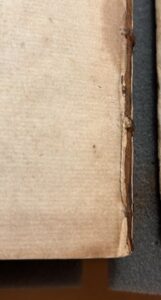
Fig. 1: Spinal binding
Sadly, the binding is in much poorer condition. It is precarious holding Humphrey’s work; so little of the binding remains that pages could easily become torn from the book if readers are not delicate. The binding looks to be composed of leather, with a white string used in the spinal binding (See Fig. 1).
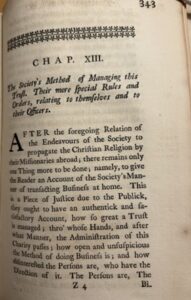
Fig. 2: Signature page marking
The book is no longer one complete work. Rather, the binding splits in different locations (beginning at the map page), creating separate sections of pages bound together. Characteristic of the printing process, most pages include “signature page marks” where a letter represents each section, with each page of the section numbered (See Fig. 2).
The book’s ink is well-preserved, with no prominent ink splotches or bleeds on the paper. The typeface is characteristic of other early modern books. The type setters chose to primarily employ the Letterpress Text font, but some sections (chapter titles in particular) are Italique 1557 (myfonts.com/pages/whatthefont). Almost every page contains certain special italicized words, such as Briti[s]h (See Fig. 3).
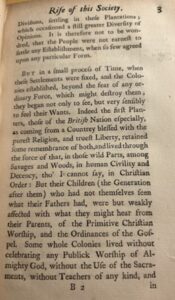
Fig. 3: Italicized words
One aspect of the text that may baffle readers is the absence of the letter ‘s.’ Rather than using s in words, Humphreys chose to use f, spelling words such as Christian as Chriftian (as seen in the above image). Despite what readers may perceive today, the “long s” Humphreys employs is simply a different letter model for s, rather than the letter f. Save for this different model for s, the book is easy to read for readers such as myself and previous students.
The arrangement of text in An Historical Account of the Incorporated Society is intriguing. Marginal notes abound on virtually every page. Downing printed these numerous small notes next to the larger text rather than writing any by hand. These marginal additions provide brief context on the topics discussed in the text as in this image that clarifies that changes to the “bylaws and lea[s]es” of the Incorporated Society for the Propagation of the Gospel in Foreign Parts to require a majority quorum of voting members (See Fig. 4).
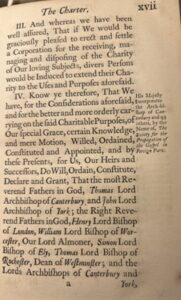
Fig. 4: Marginal text
Some marginal notes appear to be portions of the text that went unprinted initially, but others are simple comments and do not seem to fit within the larger text. Perhaps Jospeh Downing printed the marginal notes both to add new comments and include sentences missed in the initial printing. Some pages contain catchwords that assist printers by indicating the next page’s first word (See Fig. 5). Numerous pages throughout the book display black and white ornamental illustrations (not images). Decorative border pieces adorn the beginning and end of chapters (See Fig. 6).
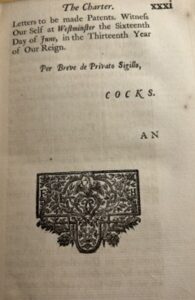
Fig. 6: Decorative border
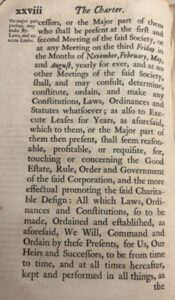
Fig. 5: Catch words
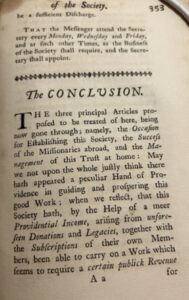
Fig. 7: Fleur-de-lis
Smaller fleurs-de-lis create boundaries between different sections/chapters on the same page (See Fig. 7). The most recognizable illustration is the royal seal of England. The seal appears at the beginning of the Charter/preface section, meant to lay out the goals of the Society and thank the monarchs William III (who assisted in founding the society) and George II (the British king in 1730). These numerous illustrations and gold lining along the edges of the rear cover indicate the significant financial investment made by the Society into printing a visually stunning book that retains its beauty today even without a functional binding.
The work came to Dickinson College from the collection of well-regarded eighteenth-century Philadelphia politician and businessman Isaac Norris. The Norris Collection holds nearly two thousand books on numerous intellectual topics. Mary Dickinson and her husband John donated the collection to Dickinson College in 1783, the same year the college opened. I am excited to continue the work of previous students in unpacking this beautiful book brought to Dickinson College 241 years ago.
Works Cited
Clapperton, R.H. The Paper-making Machine: Its Invention, Evolution, and Development.
Google Books E-Book, Pergamon Press, 1967.
“Revival of Religion.” The Religious Intelligencer, 18 Jan. 1823,
proquest.com/docview/137429704/pageviewPDF/A2297C93E1CB46F4PQ/1?
accountid=10506&sourcetype=Magazines. Accessed 15 October 2024.
“What the Font?” My Fonts, myfonts.com/pages/whatthefont. Accessed 23 September 2024.
Leave a Reply